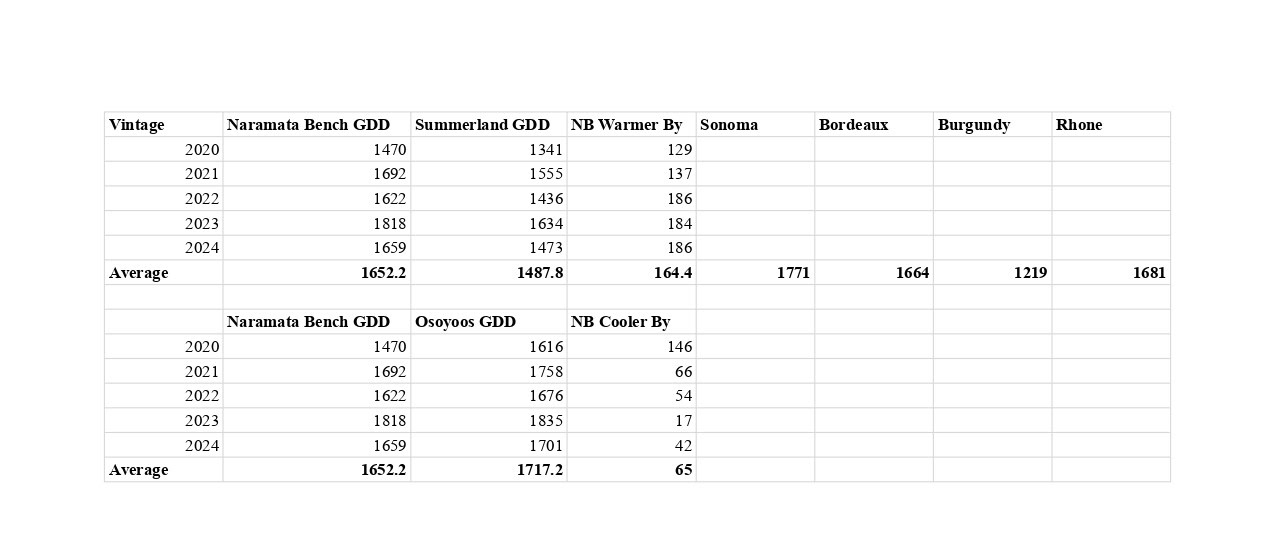For decades now it has generally been accepted that the Naramata Bench produces premium quality white wines and excellent Pinot Noir. Bigger, Bordeaux and Rhone style reds were thought to do best when grown further south, with some exceptions from the Naramata Bench, which consistently score top marks in international competitions (such as the gold medal just awarded to our 2020 Heritage Cabernet Franc at the San Francisco International Wine Awards (humble brag). Indeed, when I arrived at Hillside in 2008 I thought the same, and wondered at the fact that we were able to make excellent Merlot, Syrah and Cabernet Sauvignon from our vineyards here.
I came up with several theories for this, some of which are discussed in my blog from April 2021.
It’s almost as if we have been apologizing for making great red wines from Naramata Bench fruit!!! This ends now, and I’ll tell you why.
The Summerland Research Station–SuRDC, a division of Agriculture and Agri-foods Canada, has been tracking environmental data for decades, and specifically Growing Degree Days for the winegrape industry since 1998. Growing Degree Days (GDD) are the accumulated value of average daily temperature in excess of 10 C from April 1st to October 31st each year. This gives a good reference point to compare with other regions and previous vintages and can be a valuable tool to calm down worried winemakers, or to freak out calm winemakers. SuRDC have recorded the information from weather stations in Osoyoos and Summerland, and recently added several other weather stations.
Up until now, I have used the Summerland GDD numbers to gauge heat in our Naramata vineyards, as SuRDC was the closest weather station. Now that there is a five year data set from the Naramata Bench weather station, I had a look at how Naramata Bench compared with Summerland, Osoyoos and other regions and I was astonished by what I found.

As you can see, the Naramata Bench is on average warmer than Summerland by 10% and cooler than Osoyoos by less than 5% with the year-on-year trend tightening this gap to only 2.5% in 2024! Moreover, the Naramata Bench GDD values correspond closely to those of Sonoma, Bordeaux and the Rhone.
This data reflects the conditions mentioned in my previous blog. Proximity to the lake, west-facing aspect and late afternoon sun reflected off the lake all result in the higher GDD number, and the quality of the red wines shows the impact of this heat on ripening.
We know that, due to its location north of Osoyoos, the Naramata Bench experiences later advent of phenological stages, with budbreak, bloom, and veraison occurring one to two weeks after they do in Osoyoos. This pushes the peak sugar-ripening period to a bit later in the season, when the days are shorter and not as hot.
Why is this important? In very warm areas, sugar-ripening tends to come on too quickly, with grapes adding so much sugar that alcohol levels will be ridiculously high, the wine will be un-balanced and the fermentation may stick. Tannin ripening, on the other hand, is about hang-time, so having the sugar accumulate more slowly allows the fruit to fully ripen before through-the-roof sugars necessitate picking before flavour and tannins are fully ripe,as often happens in Napa, and sometimes Osoyoos.
The result is beautifully balanced Naramata Bench red wines, with elegant tannins playing off ripe fruit flavours.
Faced with a devastating freeze in January 2024, Naramata Bench vineyards enjoyed slightly warmer temperatures than their Similkameen or Oliver counterparts, due to the warming effect of the lake. While most reds will have to be re-trained from the roots, the actual plant death was very low in our Merlot, Cabernet Sauvignon, Gamay and Syrah blocks.
Ok so we agree to stop showing surprise that the Naramata Bench can get red grapes ripe—what else? Well, the soils, created by the lake flooding during the last ice age, have a makeup and complexity that result in very balanced sound fruit. Favourable soil pH results in fruit that is easy to work with in the cellar, presents fresh bright fruit aromas and flavours, and allows for extended aging in barrel and bottle. I recently returned from the Piedmont region of Northern Italy, with clay-rich soils that produce wines of similar brightness, age-ability and scrumptiousness. Lucky us…lucky you!
In the coming year we will have limited white wines for sale, due to the January 2024 freeze, but fortunately we have a healthy inventory of red wines.
Let’s shout it from the rooftops!!! Want yummy reds? Naramata Bench is the place to go!
